The movement of the Moon makes a fascinating study of celestial mechanics. Despite the light pollution it brings to the nighttime sky, we’re fortunate as a species to have a large solitary satellite to give us lessons in “Celestial Mechanics 101″
This weekend, we’ll get to follow that motion as the Moon crosses into the constellation Taurus for a near-pass of the planet Jupiter, and for a very few citizens of our fair world, occults it.
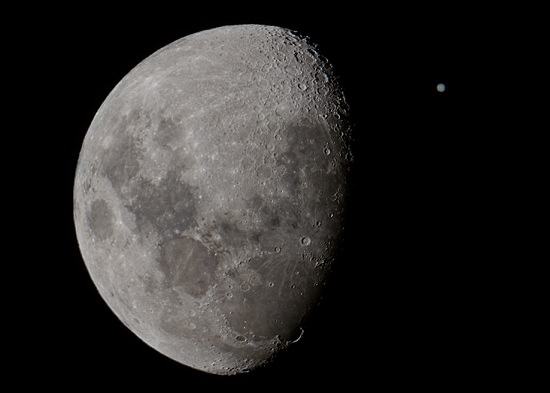
In astronomy, the term “occultation” simply means that one astronomical body passes in front of another. The term has its hoary roots in astronomy’s ancient past; just like the modern day science of chemistry sprung from the pseudo-science of alchemy, astronomy was once intertwined with the arcane practice of astrology, although the two have long since parted ways. When I use the term “occultation” around my non-space geek friends, (I do have a few!) I never fail to get a funny look, as if I just confirmed every wacky suspicion that they ever had about us backyard astronomers…
But those of us who follow lunar occultations never miss a chance to observe one. You’ll actually get to see the motion of the Moon as it moves against the background planet or star, covering it up abruptly. The Moon actually moves about 12° degrees across the sky per 24 hour period.

On the evening of Monday, February 18th, the 56% illuminated waxing gibbous Moon will occult Jupiter for Tasmania and southern Australia around 12:00 Universal Time (UT). Folks along the same longitude as Australia (i.e., eastern Asia) will see a close pass of the pair. For North America, we’ll see the Moon approach Jupiter and Aldebaran of February 17th (the night of the Virtual Star Party) and the Moon appear past the pair after dusk on the 18th.
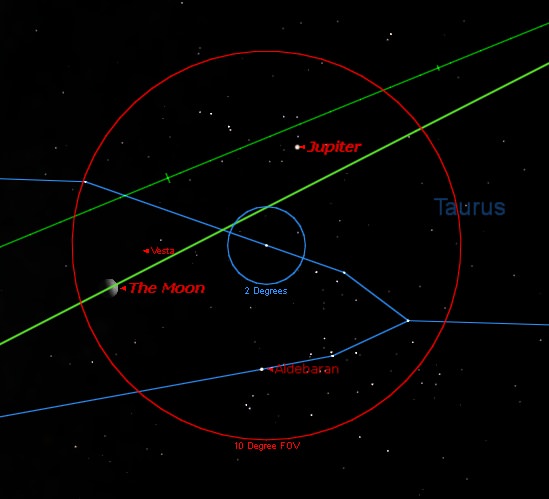
But fret not; you may still be able to spot Jupiter near the Moon on the 18th… in the daytime. Daytime planet-spotting is a fun feat of visual athletics, and the daytime Moon always serves as a fine guide. Jupiter is juuuuuust bright enough to see near the Moon with the unaided eye if you know exactly where to look;
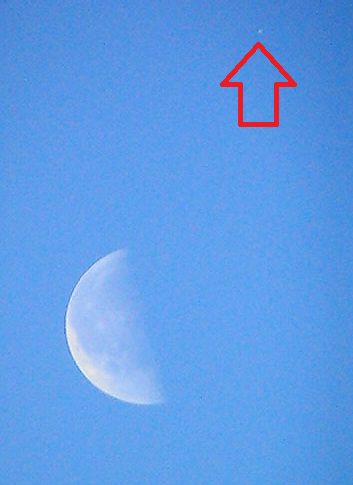
To see a planet in the daytime, you’ll need a clear, blue sky. One trick we’ve used is to take an empty paper towel tube and employ it as a “1x finder” to help find our target… binoculars may also help! To date, we’ve seen Venus, Jupiter, Sirius & Mars near favorable opposition all in the daylight… Mercury and Vega should also be possible under rare and favorable conditions.
This week’s occultation of Jupiter is the 3rd and final in a series that started in December of last year. The Moon won’t occult a planet again until an occultation of Venus on September 8th later this year, and won’t occult Jupiter again until July 9th, 2016. We’re also in the midst of a long series of occultations of the bright star Spica (Alpha Virginis) in 2013, as the Moon occults it once every lunation from somewhere in the world. Four major stars brighter than +1st magnitude lie along the Moon’s path near the ecliptic; Spica, Aldebaran, Regulus, and Antares which we caught an occultation of in 2009;
Also of note: we’re approaching a “plane-crossing” of the Jovian moons next year. This means that we’ll start seeing Callisto casting shadows on the Jovian cloud tops this summer on July 20th, and it will continue until July 21st, 2016. The orbits of the Jovian moons appear edge-on to us about every five years, and never really deviate a large amount. Callisto is the only moon that can “miss” casting a shadow on the disk of Jupiter in its passage. The actual plane crossing as seen from the Earth occurs in November 2014. Jupiter reaches solar conjunction this year on June 19th and doesn’t come back into opposition until early next year on January 5th. 2013 is an “opposition-less” year for Jupiter, which occurs on average once per every 11-12 years. (One Jovian orbit equals 11.8 Earth years).
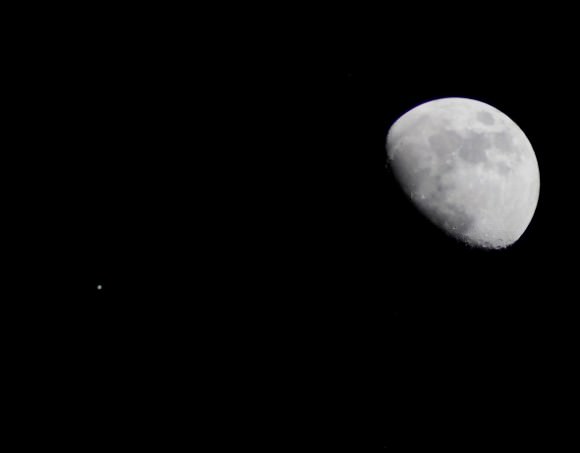
But wait, there’s more… the Moon will also occult +7.7th magnitude 4 Vesta on February 18th at~21:00 UT. This occultation occurs across South America and the southern Atlantic Ocean. It would be fun to catch its ingress behind the dark limb of the Moon, and we bet that a precisely timed video might just show evidence for Vesta’s tiny angular diameter as it winks out. For North American observers, Vesta will sit just off the northern limb of the Moon… if you have never seen it, now is a great time to try!
Finally, we realized that also in the field with 4 Vesta is an explorer that just departed its environs, NASA’s Dawn spacecraft. Although unobservable from Earth, we thought that it would be an interesting exercise to see if it gets occulted by the Moon as well this week, and in fact it does, for a very tiny slice of the planet;
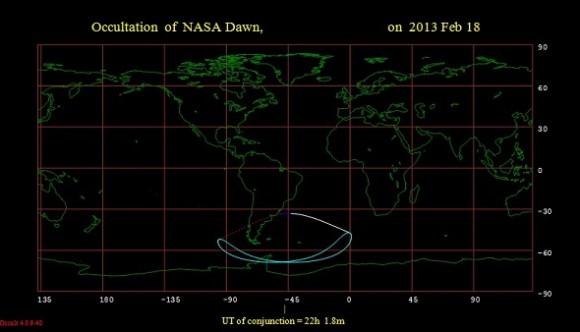
Hey, calculating astronomical oddities is what we do for fun… be sure to post those pics of Jupiter, the Moon and more up to our Universe Today Flickr page & enjoy the celestial show worldwide!
See more of Luis Argerich’s astrophotography at Nightscape Photography.
Graphics created by author using Stellarium, Starry Night and Occult 4.0 software.

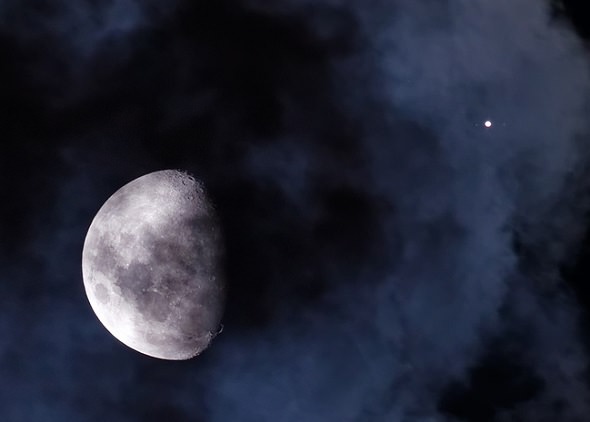
PARECE INCREÍBLE ,INCLUSO YO MISMO DUDO DE ESTO…HOY HE VISTO DETRÁS DE LA BELLA Y ENAMORADIZA LUNA UN ARO AZUL QUE INTENTA ASOMARSE EN SU LADO IZQUIERDO ,ADEMAS ,ME CONVENCIÓ DE CUATRO O CINCO CARAS DE VARIOS COLORES Y DIMENSIONES , BAJÁNDOSE EN SUS LABIOS , EN ELLA. MI LUNA VA A ENLOQUECERME ,NO IMPORTARÍA UNA DEMENCIA LUNAR,SI ALGUIEN ME CREYESE ,ELLA ESTA FECUNDA Y PROLIJA MISTERIOS…AMO A LA LUNA .ES AMOR PLATÓNICO,PERO LA ADORO.
I just saw the moon occult Jupiter and its four Galilean moons in Melbourne, Australia. Looking with a 100mm Celestron Newtonian telescope. Could also see Jupiter disappear with the naked eye.
It was really beautiful with the fires around Melbourne making the moon change from white to gold to red as the occultation occurred. Unfortunately the moon was clouded out before Jupiter re-emerged.
Makes me really want to buy a better telescope with a camera. 🙂
Just shot this on Feb. 18th, in Saigon, Vietnam: http://www.gypsycreative.com/moon_jupiter.jpg